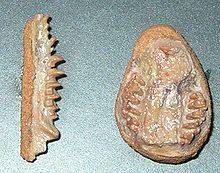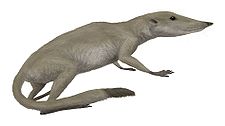- Zalambdalestes
-
Zalambdalestes
Temporal range: Late Cretaceous
Zalambdalestes lechei skull and lower jaw, Museum of Evolution Warsaw. Scientific classification Kingdom: Animalia Phylum: Chordata Class: Mammalia Superorder: †Anagalida? Family: †Zalambdalestidae Genus: Zalambdalestes
Gregory & Simpson, 1926Species - Z. lechei Gregory & Simpson, 1926 (type)
Zalambdalestes (meaning much-like-lambda robber) was a placental mammal living during the Upper Cretaceous in Mongolia. It is one of the oldest examples of a placental mammal known, and would have lived alongside the dinosaurs.
Zalambdalestes was a shrew-like animal with a long snout, long teeth, a small brain and large eyes. It was about 20 centimetres (8 in) long, with a head only 5 centimetres (2 in) long. It had strong front paws and even stronger rear ones, but its claws were not opposable, so it is unlikely to have climbed trees. Its diet was probably composed mainly of insects that it hunted in the forest undergrowth using its sharp, interlocking teeth.[1]
References
- Parker, Steve. Dinosaurus: the complete guide to dinosaurs. Firefly Books Inc, 2003. Pg. 402
External links
- Cretaceous mammals
- Prehistoric placental mammals
- Prehistoric mammal stubs
Wikimedia Foundation. 2010.

